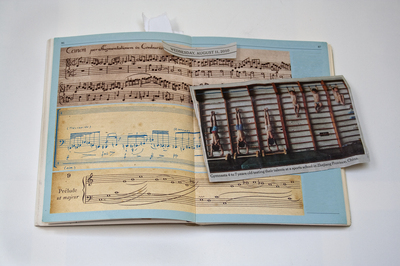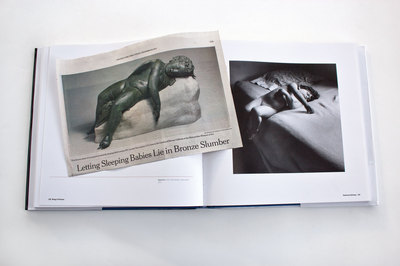Joanne Leonard exhibit at U-M plays with notions of time

“Music and boys on bars” by Joanne Leonard (August 11, 2010, news photo: Gymnasts 4 to 7 years old in Zheijiang Province, China, testing their talents at a sports school, Reuters. Book reproduction: ‘Numbers: The Universal Language’ by Denis Guedj (Harry N. Abrams, 1997).)
courtesy of the University of Michigan Institute for the Humanities
This colorful series of 22 oversized wall-mounted photographic artworks by U-M art professor Leonard consists of book-bound art reproductions set against overlaid newspaper photos and headlines whose meanings balance each other as social gesture and personal principle.
The photos affirm particular stances even as they internally question the relation of the work’s imagery itself; just as the notion of trompe-l’oeil calls into the question the arrangement of Leonard’s art collage itself.
As Wendy Kozol, professor of comparative studies at Oberlin College, says in her introductory catalog statement, “For the last four decades, Joanne Leonard has used photography, collage, and other mixed-media to create visual narratives of female subjectivity that explore the joys and pains of domestic intimacies.
“In the last past decade, Leonard’s work has increasingly moved towards explorations of the intersections of memoir and public histories. She uses collages of drawings, photographs, and print material to visualize a fragmented and non-linear family history that is anything but singular and private.”
Subtract drawing from these works and this is precisely what Leonard has done with this set of photographs. In these pregnant artworks, the private becomes public just as the public ultimately becomes private.
Indeed, as Amanda Krugliak, curator at the U-M Institute for the Humanities, aptly notes in her introduction to the exhibit, “Before long, through a carefully considered sleight of hand, these trompe-l’oeil photographs defy all presumptions and constructs of time, upending any notion we have about history and our place in it, or some record left for posterity’s sake.
“The uncanny relationship between visual representations decades apart suggests our uniqueness is more predictable than we think, like the roll of sixes in a game of dice, or the Jack of Spades in a deck of cards … noteworthy, but not beyond replication.”
Perhaps the singular indication as to what Leonard is doing with this work lies in her display’s title because “trompe-l’oeil” is a very specific kind of art—one that wouldn't seem to apply to photography.
Trompe-l’oeil is a technique whose realistic imagery creates the illusion that the objects depicted appear in three-dimensions. Yet Leonard’s oversized photography dispenses with what Krugliak has dubbed this “sleight of hand” in favor of calling attention to the images that create her compositional binaries.
What Leonard seems to be saying through illustration is that photography’s arguably a sort of trompe-l’oeil art insofar as it is typically considered the depiction of the real world as seen by other means. This strategy essentially doubles down the aesthetic stakes by adding supplementary meanings to each composite arrangement. The result is words and facts playfully commenting on each other through their implied similarities and quite literal dissimilarities.

“Bronze baby and Julia from Joanne’s ‘Being in Pictures’” (December 30, 2011, Bronze statue of Eros sleeping, 3rd century B.C. to early 1st century A.D., Metropolitan Museum of Art Rogers Fund, 1943. Book reproduction “Julia, half asleep” in ‘Being in Pictures’ by Joanne Leonard (University of Michigan Press, 2008).)
courtesy of the University of Michigan Institute for the Humanities
The photographic images of Julia and Eros are strikingly parallel. Maybe Leonard had seen the bronze before or maybe the similarities are merely a remarkable coincidence. What is not coincidence is the contrast of gender. And this internal contradiction gives “Bronze Baby and Julia” an opposition that Leonard (whose prior work has focused on sexual politics) might mischievously enjoy.
This sort of puckish humor is also to be found in “Bush and Angela Merkel with top hats (lecterns)” that puns the 1979 Mayflower book edition of Lewis Carroll and John Tenniel’s 1889 ‘The Nursery “Alice’” with a 2008 Reuters news photo. As well as “Music and boys on bars” that juxtaposes a 2010 news photo of Chinese adolescent gymnasts with a book reproduction of Denis Guedj’s 1997 musically-notated “Numbers: The Universal Language.”
Weaving good-natured internal oppositions, Leonard’s trompe-l’oeil is related to the definition of such art only in the way post-modernism cunningly ricochets against prior periods of art history. There’s a penetrating significance in each of these photographs that’s wrapped in a spirited enigma that leaves it up to the viewer to determine how much of what’s on display reflects Leonard’s personal view as opposed to artifice. And this, perhaps, is more than trompe-l’oeil enough.
“Newspaper Diary: Trompe-l’Oeil Photography” will continue through May 31 at the University of Michigan Institute for the Humanities’ Exhibition Space, Room 1010, 202 S. Thayer St. Gallery hours are 9 a.m.-5 p.m. Monday-Friday. For information, call 734-936-3518.


Comments
Judith Adell
Tue, Apr 24, 2012 : 10:33 p.m.
This work of yours, Joanne, seems quite interesting.